Energy production in July of 2021
In July, the year-on-year decline in raw coal production of industries above designated size narrowed, crude oil production was basically stable, the growth rate of natural gas production slowed down, and the growth rate of power production accelerated. Taking July 2019 as the base period, the two-year average growth rate of raw coal production decreased, the growth of crude oil production remained stable, and the production of natural gas and electricity increased rapidly.
I. Raw Coal, Crude Oil and Natural Gas Production and Relevant Information
The decline in raw coal production narrowed. In July, the production of raw coal was 310 million tons, a year-on-year decrease of 3.3 percent, 1.7 percentage points of decline rate narrower over the previous month, a decrease of 6.9 percent over the same period in 2019, an average decrease of 3.5 percent in two years, and the average daily output was 10.13 million tons; the imported coal was 30.18 million tons, a year-on-year increase of 15.6 percent.
From January to July, 2.26 billion tons of raw coal were produced, a year-on-year increase of 4.9 percent, an increase of 4.8 percent over the same period in 2019, and an average increase of 2.4 percent in two years; 169.74 million tons of coal were imported, a year-on-year decrease of 15.0 percent.
The comprehensive trading price of port coal continued to rise. On July 30, the comprehensive transaction prices of 5500, 5000 and 4500 kcal thermal coal in Qinhuangdao Port were 845, 773 and 686 yuan per ton respectively, up 26, 34 and 38 yuan respectively compared with June 25.
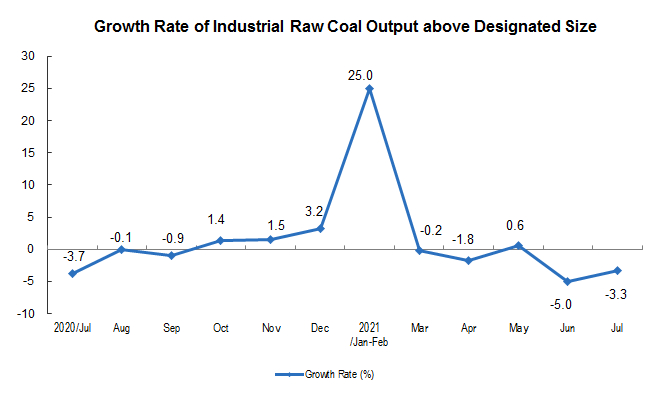
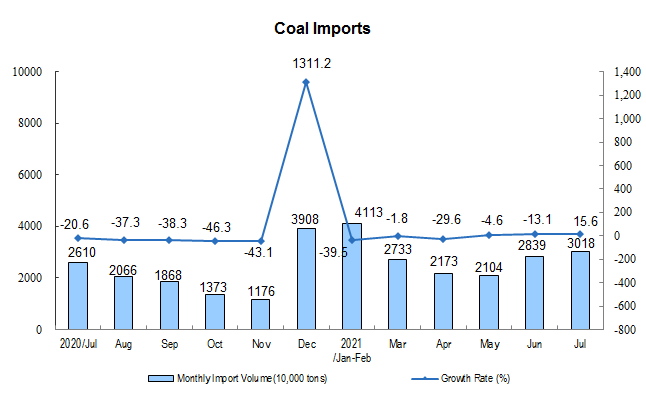

Crude oil production increased steadily, and processing capacity changed from increase to decrease. In July, it produced 16.87 million tons of crude oil, a year-on-year increase of 2.5 percent, an increase of 3.1 percent over the same period in 2019, an average increase of 1.5 percent in two years, and an average daily output of 544,000 tons; 59.06 million tons of crude oil were processed, a year-on-year decrease of 0.9 percent, an increase of 11.4 percent over the same period in 2019, an average increase of 5.6 percent in two years, and an average daily processing of 1.905 million tons.
From January to July, 116.21 million tons of crude oil were produced, with a year-on-year increase of 2.4 percent, an increase of 3.9 percent over the same period in 2019, and an average increase of 1.9 percent over the two years; 412.41 million tons of crude oil were processed, with a year-on-year increase of 8.9 percent, an increase of 11.4 percent over the same period in 2019, and an average increase of 5.5 percent over the two years.
The decline in crude oil imports narrowed and the international crude oil price fluctuated at a high level. In July, the imported crude oil was 41.24 million tons, a year-on-year decrease of 19.6 percent; from January to July, imported crude oil was 301.83 million tons, a year-on-year decrease of 5.6 percent. On July 30, the spot FOB price of Brent crude oil was US 77.72 USD per barrel, up 1.0 percent from 76.94 USD per barrel on June 30.
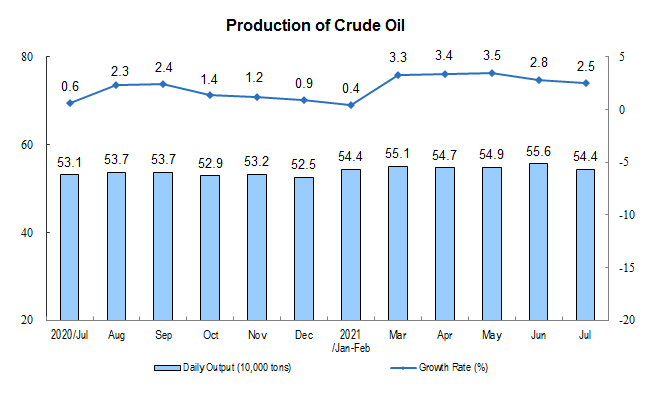
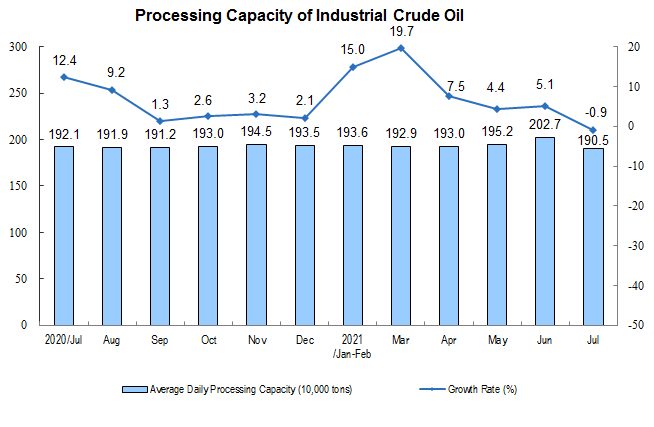


The growth rate of natural gas production slowed down. In July, the production of natural gas was 15.8 billion cubic meters, a year-on-year increase of 9.8 percent, a decrease of 3.3 percentage points over the previous month, an increase of 15.1 percent over the same period in 2019, an average increase of 7.3 percent over the two years, and an average daily output of 510 million cubic meters.
From January to July, 120.2 billion cubic meters of natural gas were produced, with a year-on-year increase of 10.7 percent, 21.2 percent higher than the same period in 2019, and an average increase of 10.1 percent in two years.
Natural gas imports grew rapidly. In July, 9.34 million tons of natural gas were imported, a year-on-year increase of 27.0 percent. From January to July, 68.96 million tons of natural gas were imported, a year-on-year increase of 24.0 percent.
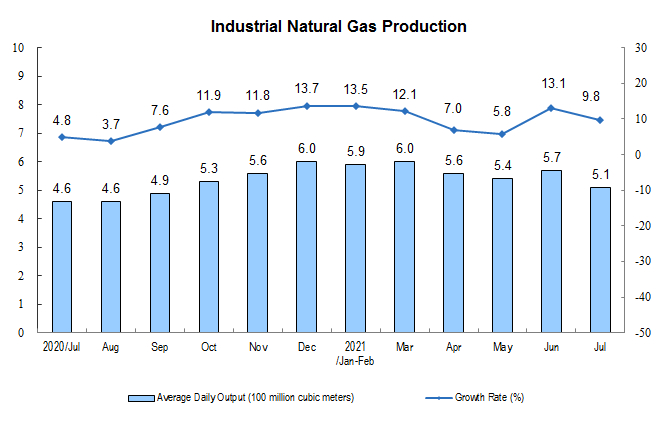
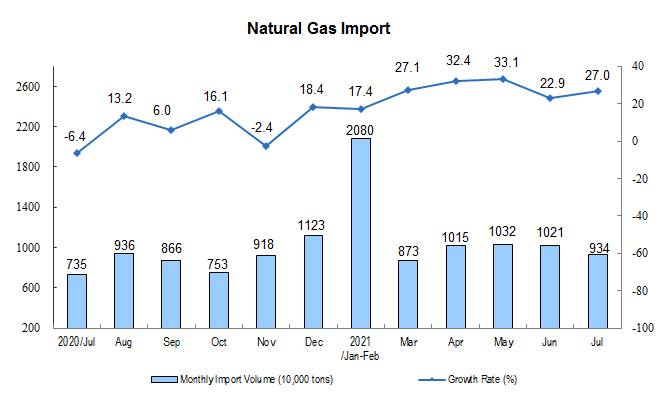
II. Electric Power Production
Power production accelerated. In July, the power generation was 758.6 billion kwh, a year-on-year increase of 9.6 percent, the growth rate was 2.2 percentage points higher than that of the previous month, an increase of 11.7 percent over the same period in 2019, an average increase of 5.7 percent over the two years, and the average daily power generation was 24.47 billion kwh. From January to July, the power generation was 4,645 billion kwh, a year-on-year increase of 13.2 percent, an increase of 12.2 percent over the same period in 2019, and an average increase of 5.9 percent in the two years.
In terms of varieties, thermal power, nuclear power and wind power all grew rapidly in July, the decline of hydropower narrowed, and solar power fell slightly. Among them, thermal power increased by 12.7 percent year-on-year, with July 2019 as the base period, with an average growth of 5.8 percent in two years; hydropower decreased by 4.3 percent, with an average growth of 0.8 percent in the two years; nuclear power increased by 14.4 percent, with an average growth of 10.5 percent in the two years; wind power increased by 25.4 percent, with an average increase of 24.3 percent in two years; solar power generation increased by 12.1 percent, with an average growth of 5.5 percent in the two years.
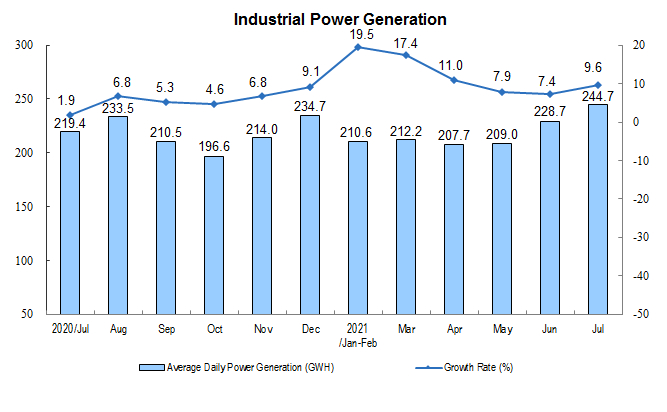
Annotations:
1. Explanatory Notes
Average daily product output: It is calculated by dividing the total output of Industrial Enterprises above the designated size announced in that month by the calendar days of that month.
2. Statistical Coverage
The statistical caliber of the output data in the report is above the designated size of industry, and the statistical scope is industrial enterprises with annual main business income of more than 20 million yuan.
Because the scope of Industrial Enterprises above the designated size changes every year, in order to ensure that this year's data is comparable with the previous year's, the same period used to calculate the growth rate of various indicators such as product output is consistent with the statistical scope of enterprises in this period, and there is a caliber difference between the data released last year.
3. Data Source
Import data comes from the General Administration of Customs, of which March data are express data; coal price data comes from China Coal Market Network; crude oil price data comes from the United States Energy Information Agency (EIA).
4. Conversion relationship of natural gas units: 1 ton is equal to 1380 cubic meters.
5. The two-year average growth rate refers to the growth rate calculated by geometric average method based on the corresponding number of the same period in 2019.
